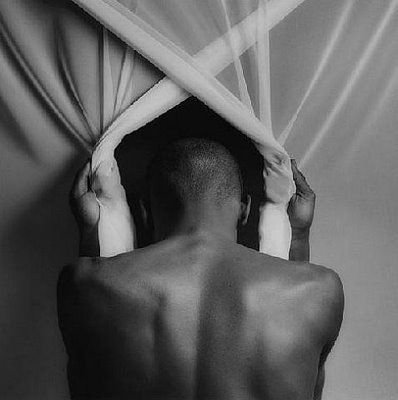Robert Mapplethorpe. Perfection in Form” @ the Galleria dell’Accademia
Robert Mapplethorpe, Lisa Marie, 1987, gelatin silver print, 20 x 24 in. © 1987 Robert Mapplethorpe Foundation.
FLORENCE.- “The most beautiful Mapplethorpe show I’ve ever seen,” exclaimed Patti Smith at the grand opening (May 25) for “Robert Mapplethorpe. Perfection in Form.” Standing at the feet of Michelangelo’s David, and flanked by Mapplethorpe’s photographs of male nudes, Smith added, “This show is the realization of Robert’s dream.” Mapplethorpe's first muse and companion, Smith provided the spark for the exhibition. Visiting the museum in 2007 with Renaissance art historian Jonathan Nelson, she explained that Mapplethorpe adored Michelangelo. Nelson, together with Franca Falletti, director of the Galleria dell’Accademia, curated the exhibition dedicated to the internationally acclaimed American photographer on the twentieth anniversary of his death. At the opening, Michael Ward Stout –president of the Robert Mapplethorpe Foundation— proclaimed the exhibition “the most important event in Mapplethorpe's artistic life.” For Edward Mapplethorpe, Robert’s brother and former assistant, and a photographer himself, “Displaying these works side-by-side is deeply moving; the silence, beauty, and arrangement are striking.”
The exhibition presents, for the first time, the works of Mapplethorpe in a “temple of art” like the Galleria dell’Accademia. For the Florentine State museums, it is also the first major photography show, and the first major show dedicated to an American artist. At the crowded opening Falletti was delighted to see so many young people who do not usually attend these events. “Right from the start, the exhibition is attracting a new audience to the Galleria dell’Accademia. Mapplethorpe is introducing the masters that inspired him to the artists of tomorrow.” For Nelson, “Our challenge was to create a conversation between the past and present. When you put a Mapplethorpe next to a Michelangelo, you see more than one work plus another. The juxtaposition changes how you see both artists, and creates something new: a visual dialogue.”
From its very title, exhibition curators Falletti and Nelson express the profound principle that associates the American photographer with Renaissance masters and, in particular, with Michelangelo. Both artists aimed for perfection by means of the geometric rigor of volumes as defined by line and sculpted by light. Mapplethorpe himself expressed this idea when he stated: “I look for perfection in form … I am trying to capture what could be sculpture.” Mapplethorpe and Michelangelo sought the balance, precision and clarity inherent in ‘Form,’ and this provides the basis for a comparison between their works. According to Stout, “Mapplethorpe’s real love had been for Old Master work. He had strived to capture in his photography the perfection of form that he perceived in the works of Michelangelo and other Renaissance masters.”
The exhibition also proposes a new link between the artists: the combination of equilibrium and dynamic muscular tension that characterizes Mapplethorpe’s works derives directly from Michelangelo's. Thus, photographs of Thomas in a circle appear next to Michelangelo's prisoners. The photographer once said: “If I had been born one hundred or two hundred years ago, I might have been a sculptor, but photography is a very quick way to see, to make sculpture”. Another time, talking about his photographs of the first female body builder, Mapplethorpe said, “Lisa Lyon reminded me of Michelangelo’s subjects, because he did muscular women.” The show presents photographs of Lyon alongside Michelangelo's painting of Venus.
The first section is hosted in the museum area of the Galleria dell’Accademia, offering a direct comparison between works in different genre (sculpture and photography) and cultures (Renaissance Florence and 1970s-80s New York). In the exhibition space, Falletti explains, “The material presented is grouped into four sections: Geometry of Form, Fragment as Form, Repeating Form, and Sculptural Form. These address different aspects of one great theme: Form. This is understood as a value in itself, distinct not only from the objective content, that is, the subject matter represented, but also by the subjective content, that is, the baggage of personal experience transmitted through the image.”
The 111 works include Michelangelo's sculptures from the museum, four drawings and a wax model also by Michelangelo, and works by modern masters that Mapplethorpe admired: Andy Warhol, Man Ray, Brice Marden. The 93 works by Mapplethorpe span his entire career and represent the three main genre defined by the artist: nudes (male and female), portraits (including Patti Smith and Philip Glass, who will both perform at the museum), and still-lifes (especially flowers). Several are very rare, many have never been exhibited in Italy, all (but two) come from the Robert Mapplethorpe Foundation in New York.
Robert Mapplethorpe, Ajitto, 1981 © 1981 Robert Mapplethorpe Foundation.
Robert Mapplethorpe, Lisa Lyon, 1982, gelatin silver print © 1982 Robert Mapplethorpe Foundation.
Robert Mapplethorpe, Thomas, 1987 © 1987 Robert Mapplethorpe Foundation.
Robert Mapplethorpe, Phillip Prioleau, 1982 © 1982 Robert Mapplethorpe Foundation.
Robert Mapplethorpe, Derrick Cross, 1985, gelatin silver print, 16 x 20 in. © 1985 Robert Mapplethorpe Foundation.
Robert Mapplethorpe, Ken and Lydia and Tyler, 1985, silver gelatin print, 15 1/8 x 15 1/8 inches © 1985 Robert Mapplethorpe Foundation.

/https%3A%2F%2Fprofilepics.canalblog.com%2Fprofilepics%2F1%2F0%2F100183.jpg)
/https%3A%2F%2Fstorage.canalblog.com%2F03%2F02%2F119589%2F96711876_o.jpg)
/https%3A%2F%2Fstorage.canalblog.com%2F11%2F31%2F119589%2F94773502_o.jpg)
/https%3A%2F%2Fstorage.canalblog.com%2F20%2F83%2F119589%2F94772815_o.jpg)
/https%3A%2F%2Fstorage.canalblog.com%2F26%2F72%2F119589%2F75604929_o.jpg)
/https%3A%2F%2Fstorage.canalblog.com%2F59%2F60%2F119589%2F26458628_o.jpg)









/image%2F1371349%2F20240309%2Fob_46fcb2_exposition-mapplethorpe-a-la-galerie-r.jpg)
/http%3A%2F%2Fstorage.canalblog.com%2F26%2F81%2F119589%2F121270258_o.jpg)
/http%3A%2F%2Fstorage.canalblog.com%2F64%2F24%2F119589%2F113154811_o.jpg)
/http%3A%2F%2Fstorage.canalblog.com%2F21%2F11%2F119589%2F111706210_o.jpg)